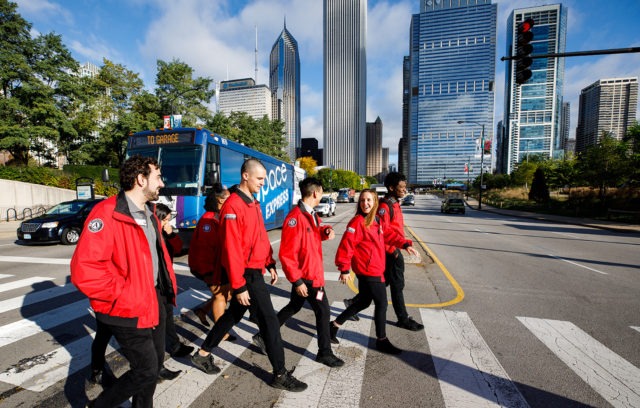City Year can prepare you for a career in change management
City Year’s alumni community is extraordinary. Now numbering nearly 40,000, this group of engaged leaders, professionals, entrepreneurs, neighbors, parents and changemakers continue to make an impact every day where they live and work, across a wide range of professions and communities.
Based on results from a 2022 survey, about 50% of City Year alumni work in the education sector: 13% as classroom teachers; 13% work in other areas of the education sector, including as administrators, counselors, social workers and in higher education; and 14% work at education nonprofits. Together, they are helping to transform learning environments for thousands of students across the country.
We’re proud of our City Year alums who go on to contribute to many other sectors, such as business, law, health care, entrepreneurialism, government, environmental conservation, and more.
Learn about Ruhamah Dunmeyer Grooms, City Year Columbia ’10, and how she says her City Year experience helped her find her path into change management.

Finding your career path after secondary education
Like many young people, Ruhamah Dunmeyer Grooms was unsure what to do after she graduated from Columbia College with a degree in behavioral science in 2009. She heard about a youth development program City Year hosted on weekends at the time, called Young Heroes, designed to help students engage with their community through service projects and learn about social justice issues, and decided to apply to serve as an AmeriCorps member—an experience she says helped her figure out her next professional steps.
Today, Ruhamah is a Program Manager at Veterans Healthcare Administration and works as a program manager specializing in change management.
City Year prepares young people to explore careers after graduation
“When I was in undergrad, I initially thought I was going to move to DC,” recalls Ruhamah. “Somebody stopped me and said, ‘why not serve your community and have an impact?’ City Year Columbia was right here so I decided to apply to be a corps member.”
Ruhamah describes her experience as “an opportunity to impact how City Year was seen in the community.” As an AmeriCorps member she supported volunteer initiatives and spring break programs that centered around beautification projects in the community.
“Building and connecting the community to a ‘why’ and to a mission was at the core of everything that year. One of my favorite PITW is ‘inject creativity into everything.’ I like my work to be fun and creative. It’s definitely something I live by after City Year.”
PITW, or “putting idealism to work,” is a collection of ideas and values written by City Year CEO Jim Balfanz and co-founder Michael Brown.
“The biggest thing I learned at City Year is creating a beloved community,” says Ruhamah.
What is change management?
“I knew I loved working with people and connecting with them to embrace change, but I didn’t know what that would mean for me,” Ruhamah says. “City Year set me on a pathway towards figuring that out.”
After City Year, Ruhamah worked for other education non-profits because she wanted to continue addressing inequities in education. “When my alma mater [Columbia College] opened an organizational change and leadership program, that’s where I really got into how I can build organizations into better places for their people,” shared Ruhamah.
Columbia College describes the program as a way to “bring together real-world practice with a robust academic approach that is designed to strengthen personal leadership styles and leadership potential.” All organizations over time undergo some form of change in their policies and structure. However, these changes take time to plan and must be overseen with care to have a lasting impact.
“We often hear people say, ‘be the change you wish to see,’ but people don’t think about all the work that it takes to make change happen. And I’m not talking about change at a policy level, but as an individual,” observed Ruhamah. “I think of the individual first as part of the change versus the change coming in and the individual adopting to it.”
Ruhamah points out that City Year AmeriCorps members do gain experience in change management during their service year. “When you’re a corps member, you work with students and bring them to the change that they deserve to have. You provide them with resources that they might not have if you don’t step in and be the change agent.”
“Whether it’s me creating graphics, building a communications plan or just having a conversation with someone, I can be passionate about it because I’m passionate about people. If you’re at City Year then you’re definitely passionate about people processing change,” said Ruhamah.
Leaning into discomfort as an agent of change
Change is sometimes necessary, but that doesn’t always make it easy to process.
“When people are resistant to change, they’re not necessarily resistant to you or the information that you’re giving them,” advised Ruhamah. “They’re resistant to the fact they may have to give up something. It’s important to remember to not take things personally.”
Building relationships is an important key to supporting people through change in any environment, including the schoolhouse.
“Corps members have to build trust with their students in order to engage them in learning and help them pivot in the right direction. In order to pivot, you can’t take things personally because we all have good and bad days. A relationship built on trust, communication and forgiveness is part of the work,” said Ruhamah.
“I am also a firm believer in patting myself on the back,” she said. “I will treat myself to family dinners on the weekends or a massage every few months. It’s important to remember that outside of work you have to reset because you can’t pour out of an empty bucket. So, remember to build yourself up at the same time.”
Learn more about serving with City Year:
Related stories
Because you'll be living on a stipend, it might be a good idea to hold off on that ottoman from...
Read more about Furnishing your apartment on a budget: Tips for AmeriCorps membersCity Year’s “Why We Matter” podcast explores the vital role of education and mentorship in empowering young people. Through interviews...
Read more about Why City Year’s student success coach network mattersRead more and check the City Year blog to learn the soft skills our corps members gain through a year...
Read more about Top five skills employers want you to have todayIf you speak with an alum of an historically Black college or university (HBCU) about their experience, you’ll quickly learn...
Read more about Serving with City Year sharpens job skills, HBCU graduate says















